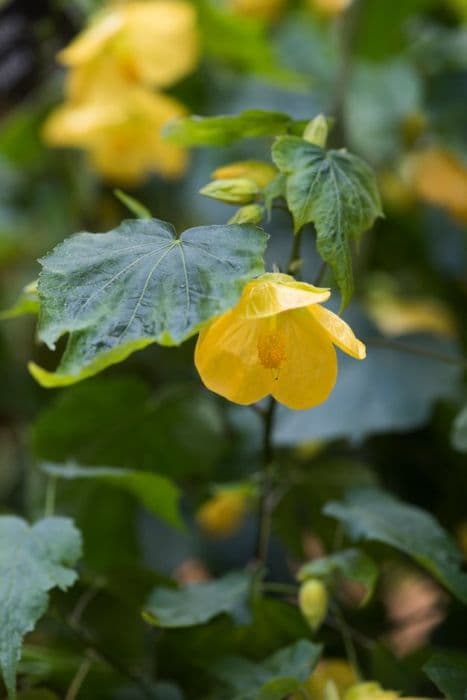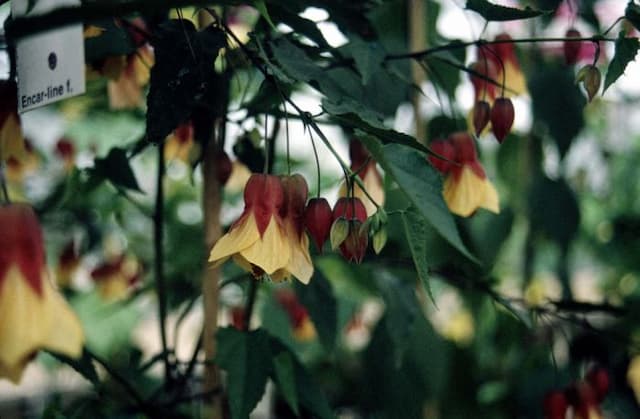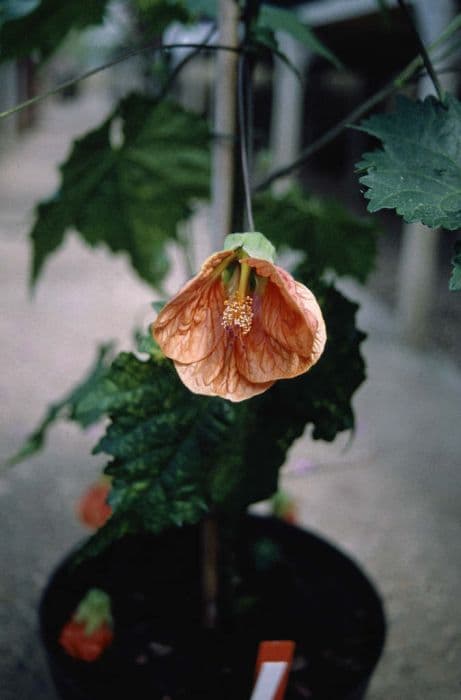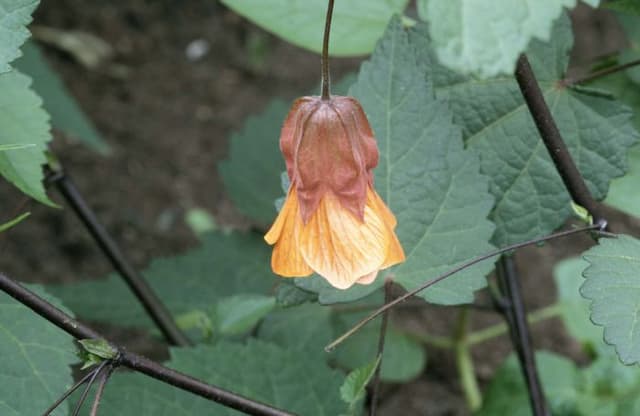Littleleaf Linden Tilia cordata 'Greenspire'

ABOUT
The 'Greenspire' is a cultivar of the small-leaved lime. It is an attractive deciduous tree with a neat, conical shape that makes it a popular choice for avenues and street plantings. The dark green, heart-shaped leaves demonstrate a fine point at the tip and are glossy, providing a lush, dense canopy that turns a golden-yellow in fall. Come early summer, the tree produces small, fragrant flowers that are pale yellow, which contribute to its ornamental value. These delicate blooms attract bees and are a source of tasty honey. The flowers are followed by small, round fruits that are inconspicuous and often go unnoticed against the dense foliage. The bark of this lime tree is smooth and gray when young, gradually becoming more fissured with age. This particular cultivar is esteemed for its uniformity and the elegance it brings to the urban and garden landscapes, where its more manageable size and adaptability to pruning are greatly valued.
About this plant
 Names
NamesFamily
Malvaceae
Synonyms
Small-Leaved Lime, Littleleaf Linden, Greenspire Linden
Common names
Tilia parvifolia, Tilia ulmifolia, Tilia bohemica, Tilia europaea, Tilia sylvestris, Tilia vulgaris.
 Toxicity
ToxicityTo humans
The Littleleaf Linden is not considered toxic to humans. In fact, various parts of the plant, such as the flowers, have been used in traditional medicine and for making teas. There are no well-documented cases of poisoning or harmful effects from ingesting the Littleleaf Linden in normal food quantities.
To pets
The Littleleaf Linden is generally recognized as safe for pets. It does not contain toxic substances that are harmful to dogs or cats, and there is no evidence suggesting that normal contact or incidental ingestion of the leaves or flowers would lead to poisoning in pets.
 Characteristics
CharacteristicsLife cycle
Perennials
Foliage type
Deciduous
Color of leaves
Green
Flower color
Yellow
Height
40 feet 12 meters (12m)
Spread
35 feet 10 meters (10m)
Plant type
Tree
Hardiness zones
3
Native area
Europe
Benefits
 General Benefits
General Benefits- Shade provider - The 'Greenspire' Littleleaf Linden offers ample shade with its dense foliage, making it ideal for parks and large gardens.
- Aesthetic appeal - With its heart-shaped leaves and symmetrical canopy, it adds visual interest and beauty to any landscape.
- Drought tolerance - Once established, it has a moderate tolerance to drought, requiring less frequent watering.
- Urban adaptability - It's resilient to urban pollution and can thrive in city environments with minimal maintenance.
- Wildlife habitat - The tree attracts bees, butterflies, and birds, providing nectar and nesting sites.
- Seasonal interest - In addition to its summer greenery, it offers fragrant yellow-white flowers in early summer and attractive yellow autumn foliage.
- Longevity - The 'Greenspire' is a long-lived tree, providing benefits for many years once it matures.
- Erosion control - Its extensive root system helps to stabilize soil and prevent erosion on slopes.
- Winter hardiness - It has a good resistance to winter damage and can withstand cold temperatures.
 Medical Properties
Medical Properties- Anti-inflammatory: Tilia cordata 'Greenspire', like other linden species, has been traditionally used for its anti-inflammatory properties.
- Anxiolytic and Sedative: The flowers of the plant are sometimes used for their calming effects, which can help alleviate anxiety and promote sleep.
- Diaphoretic: Linden flowers can induce sweating and are traditionally used to relieve fever.
- Antispasmodic: The plant has been used to help reduce muscle spasms and cramps.
- Expectorant: Linden flowers are also known to help in expelling mucus from the respiratory tract and easing coughs.
- Diuretic: It has been used to promote the production of urine which can aid in detoxification and relieve water retention.
 Air-purifying Qualities
Air-purifying QualitiesThis plant is not specifically known for air purifying qualities.
 Other Uses
Other Uses- The small-leaved lime tree is often planted in urban environments for its tolerance to pollution and its ability to survive in compacted soils.
- Wood from the small-leaved lime is soft and lightweight, making it suitable for intricate carving and is often used by sculptors and woodworkers.
- In historical instrument-making, the small-leaved lime's wood was prized for its acoustic properties and used for making lutes and other stringed instruments.
- The inner bark of the small-leaved lime, known as bast, can be processed into a fiber for making rope or woven into mats and baskets.
- Beekeepers highly value the small-leaved lime for its nectar, as it attracts bees and contributes to the production of a richly flavored honey.
- The small-leaved lime's flowers can be dried and added to potpourri mixes for their pleasant scent and decorative appearance.
- Leaves from the small-leaved lime can be used as a natural dye, providing colors ranging from yellow to a creamy off-white, depending on the mordant used.
- In marquetry and veneer-making, the small-leaved lime's wood, with its fine grain and pale color, is a popular choice for detailed inlay work on furniture.
- Children can use the seed pods and leaves in craft projects, such as making leaf rubbings or natural collages, due to their distinctive heart shape and texture.
- The small-leaved lime tree is occasionally used in agroforestry practices, providing shade for crops or livestock in integrated farming systems.
Interesting Facts
 Feng Shui
Feng ShuiThe Small-leaved Lime is not used in Feng Shui practice.
 Zodiac Sign Compitability
Zodiac Sign CompitabilityThe Small-leaved Lime is not used in astrology practice.
 Plant Symbolism
Plant Symbolism- Love: The Tilia cordata, commonly known as the Linden tree or Small-leaved Lime, is often associated with love and fertility, possibly due to the heart-shaped leaves and the tree's historic use in matrimonial ceremonies and decorations.
- Peace: In European folklore, the Linden tree is seen as a symbol of peace and tranquility. Its presence in village squares and courts of justice in Germany and the Slavic countries was an indication of a peaceful gathering place.
- Community: The Linden was traditionally planted in town centers to signify the heart of the community, serving as a gathering spot for communal meetings and celebrations, thus symbolizing unity and togetherness.
- Justice: In Germanic cultures, the Linden tree is connected to judicial matters. Judgments were often issued under its branches, signifying fairness and the pursuit of truth.
- Healing: Known for its medicinal properties, the Linden tree symbolizes healing and health. Its flowers have been used to make teas that soothe anxiety and promote relaxation.
 Water
WaterThe Little Leaf Linden (Greenspire Linden) should be watered deeply and thoroughly to ensure even soil moisture, which is critical during its establishment phase for the first few years after planting. During this period, water it once a week with about 1.5 to 2 gallons of water if there isn't sufficient rain. After establishment, water it every 2 to 3 weeks, depending on the weather conditions, with the same amount, unless the plant is situated in particularly dry or sandy soil which may require more frequent watering. In very hot or drought-like conditions, increase the frequency of watering to prevent stress.
 Light
LightFor the Greenspire Linden, full sun to partial shade is ideal, meaning it requires at least 4-6 hours of direct sunlight a day. It is adaptable but thrives best in a spot where it receives ample sunlight during the day, which promotes healthy growth and bloom production.
 Temperature
TemperatureThe Greenspire Little Leaf Linden can withstand a wide range of temperatures but thrives in environments where average summer temperatures do not typically exceed 75 degrees Fahrenheit, and winter temperatures do not fall below -30 degrees Fahrenheit. The ideal growing temperatures for this tree are between 60 and 70 degrees Fahrenheit. It is very cold-hardy and can tolerate the lower temperatures typical of the northern United States.
 Pruning
PruningPruning the Greenspire Linden is essential for removing dead or broken branches, shaping the tree, and opening up the canopy to allow light and air penetration, which helps maintain its health. It should be pruned in the late winter to early spring when the tree is dormant. Remove any damaged limbs, suckers, and any crossing branches to maintain a strong structure. Annual or biennial pruning is often sufficient.
 Cleaning
CleaningAs needed
 Soil
SoilLittleleaf Linden thrives in well-drained, fertile, loamy soil with a pH range of 5.5 to 7.5. A balanced mix of two parts loam, one part peat, and one part sharp sand will support its growth, ensuring adequate drainage and nutrient retention.
 Repotting
RepottingLittleleaf Lindens are large trees and once established in the landscape, they typically do not require repotting.
 Humidity & Misting
Humidity & MistingLittleleaf Linden is adaptable but prefers moderate humidity levels, mimicking its natural woodland habitat.
 Suitable locations
Suitable locationsIndoor
Grow Littleleaf Linden indoors with large space, bright indirect light.
Outdoor
Plant Littleleaf Linden in full sun to partial shade, sheltered from strong winds.
Hardiness zone
3-7 USDA
 Life cycle
Life cycleThe life of Tilia cordata 'Greenspire', commonly known as the 'Greenspire' Littleleaf Linden, begins with seed germination, typically occurring in spring under favorable conditions of moisture and temperature. After germination, the seedling grows into a young sapling, which then progressively matures over several years into a robust tree with a strong central trunk and a rounded crown. During its maturation, 'Greenspire' develops heart-shaped, dark green leaves and in early to mid-summer, it blooms with fragrant, yellow-white flowers which are highly attractive to bees. Following pollination, the tree produces small nutlets attached to a leafy bract, which, when mature, disperse to propagate the next generation. As a deciduous tree, the 'Greenspire' Linden experiences annual cycles of leaf growth in spring, followed by leaf senescence and abscission in fall. Throughout its lifetime, which can span several centuries, the tree undergoes regular periods of growth and dormancy, adapting to the seasonal changes in its environment.
 Propogation
PropogationPropogation time
Spring-Early Summer
The most popular method of propagating Tilia cordata 'Greenspire', commonly known as the Littleleaf Linden, is through semi-hardwood cuttings. This technique is generally carried out in the late summer after the current season's growth has started to harden. For optimal results, select healthy, disease-free branches and make cuttings that are 6 to 8 inches (15 to 20 centimeters) in length. Each cutting should have at least two to three sets of leaves, and the bottom set of leaves should be removed. The cut end of the cutting can be dipped in rooting hormone to enhance root development before being placed in a well-drained medium such as a mix of peat and perlite. The cuttings should be kept moist and in a warm, indirect light until roots have established, after which they can be transferred to individual pots or directly into the nursery row.





![Abutilon [Yellow Trumpet]](/_next/image?url=https%3A%2F%2Fplants-admin.emdemapps.com%2Fimages%2Fplants%2F%2Fimages%2F604b5caa8b4fb.png&w=640&q=75)


